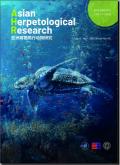Differences in Incubation Length and Hatchling Morphology among Five Species of OviparousPhrynocephalus Lizards (Agamidae) from China
IF 1.2
3区 生物学
Q2 ZOOLOGY
引用次数: 9
Abstract
We incubated eggs of five Phrynocephalus species(P.albolineatus,P.axillaries,P.grumgrzimailoi,P.helioscopus and P.przewalskii)at three constant temperatures(24°C,28°C and 32°C)to examine differences in incubation length and hatchling morphology among species and among temperature treatments.We combined data from this study with those reported previously for P.frontalis and P.versicolor to examine whether embryonic stage at laying is a causal factor for interspecific variation in incubation length,and whether the phylogenetic relationship inferred from hatchling morphology is consistent with the relationship based on mitochondrial DNA data.Mean values for incubation length differed among the five species studied herein and,in all these five species,incubation length decreased at a decreasing rate as temperature increased.In none of the five species did hatchling size(snout-vent length and body mass)and other morphological variables differ among the three temperature treatments.The seven oviparous Phrynocephalus lizards found in China differ from each other in hatchling morphology,and embryonic stage at laying is a causal factor of inter-and intra-specific variation in incubation length.The phylogenetic relationship inferred from hatchling morphology is not always consistent with the currently known relationship based on mitochondrial DNA data.Data from this study and those reported previously allow the conclusion that any Phrynocephalus species may have its unique position along the axis defined by hatchling morphology.中国五种卵生龙头蜥的孵化时间和孵化形态差异
我们对5种黄颅虫(p.a olbolineatus, p.a axillaries,P.grumgrzimailoi, p.p。在三种恒温(24°C、28°C和32°C)下,研究不同物种和不同温度处理下孵化时间和孵化形态的差异。我们将本研究的数据与先前报道的关于p.f frontalis和p.v versicolor的数据结合起来,研究产卵时的胚胎阶段是否是孵育长度变化的一个因果因素,以及从孵化形态推断的系统发育关系是否与基于线粒体DNA数据的关系一致。孵育长度的平均值在本文所研究的五种物种中有所不同,并且随着温度的升高,孵育长度均呈递减趋势。在不同的温度处理下,5个物种的孵化尺寸(口鼻长度和体质量)和其他形态变量均无差异。在中国发现的7种卵生龙在孵化形态上存在差异,产卵时的胚胎阶段是种间和种内孵化时间差异的一个原因。从幼体形态推断出的系统发育关系并不总是与目前已知的基于线粒体DNA数据的关系一致。本研究和先前报道的数据允许这样的结论,即任何Phrynocephalus物种可能在孵化形态定义的轴上有其独特的位置。
本文章由计算机程序翻译,如有差异,请以英文原文为准。
求助全文
约1分钟内获得全文
求助全文
来源期刊

Asian Herpetological Research
ZOOLOGY-
CiteScore
2.80
自引率
7.10%
发文量
441
审稿时长
>12 weeks
期刊介绍:
AHR aims to provide a forum for herpetologists and related scientists interested in conducting international academic exchanges and joint studies, and a platform for introducing their newly made scientific and technological data, and publishing their research results and achievements in the world, but focusing on the Asian-Pacific Region.
The principal criteria of AHR for acceptance of articles for publication are the quality and significance of the research, breadth of interest of the work to the readership, and the clarity and effectiveness of communication. AHR welcomes submission of manuscripts from authors in all countries of the world, though with a focus on the herpetological studies in the Asian and Pacific Region, including major articles, shorter communications and review articles.
 求助内容:
求助内容: 应助结果提醒方式:
应助结果提醒方式:


